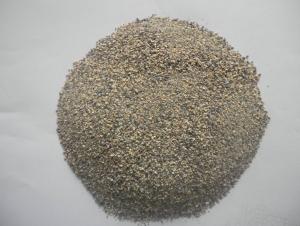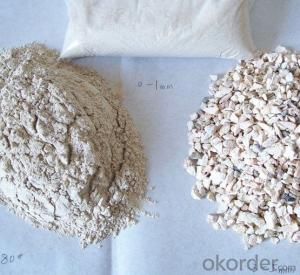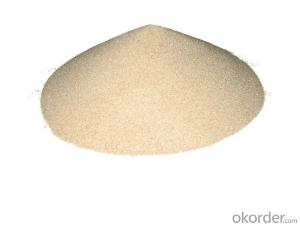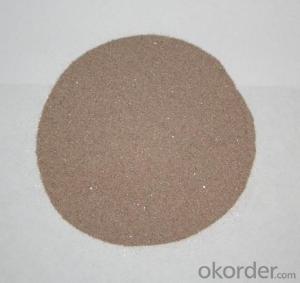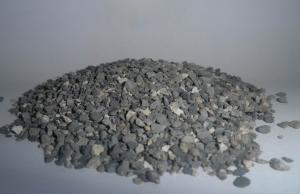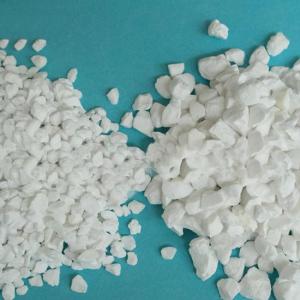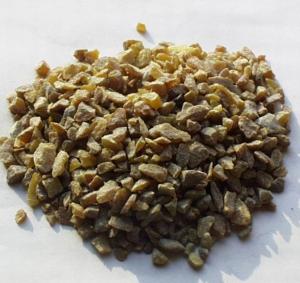Raw Materials for Refractory:Zircon Sands and Zircon Flour 66%-67% Good Performance
- Loading Port:
- Tianjin
- Payment Terms:
- TT OR LC
- Min Order Qty:
- 25 m.t.
- Supply Capability:
- 3000 m.t./month
OKorder Service Pledge
OKorder Financial Service
You Might Also Like
Refractory Material/ Zircon Sands and Zircon Flour Good Quality
1.Structure of Zircon Sand and Zircon Powder
We are offer zircon sand With Below Mention Descriptions: ZrO2 65 - 67 %. We are offer zircon sand With Below Mention Descriptions: ZrO2 65 - 67 %. Zircon is a remarkable mineral, if only for its almost ubiquitous presence in the crust of Earth. It occurs in igneous rocks as primary crystallization products, in metamorphic rocks and in sedimentary rocks as detrital grains.
Further, the mineral due to hardness, durability and chemical inertness, zircon persists in sedimentary deposits and is a common constituent of most sands.
2.Main Features of Zircon Sand and Zircon Powder
1 Tiny, round, solid ball shape provides greater surface area for improved performance and dispersion in its application
2 High refractory rating, lower specific gravity rating, and higher service temperature produces greater yield
3 With lower bulk density, it offers better air permeability for better performance as a result of its overall physical characteristics
3.Main usage of Zircon Sand and Zircon Powder
Ceramic Industries – Wall Tiles , Floor Tiles , Roofing Tiles
Sanitary Ware Industries
Pottery Industries
Porcelain Glazes
Frit for Glaze and Enamels
Ceramic Colour Industries
Admixture for Glass , Opal Glass
Picture Tube Industries
Foundries , Investment Casting Industries
Special Refractories , Castable Refractories
Zircon Bricks , Zirconium Oxide Industries
Epoxy Resin , Special Paints Industries
4. Zircon Sand and Zircon Powder Images



5. Zircon Sand and Zircon Powder Specification
1.The 80-120M zircon sand is used in investment casting, the processing is called dipping.
2.It can enhance the shell`s thickness.
3.It is specialize used in inner layer being mixed with silica sol.
4.We supply compititive price.
6.FAQ of Zircon Sand and Zircon Powder
1). Q: Are you a factory or trading company?
A: We are a factory.
2). Q: Where is your factory located? How can I visit there?
A: Our factory is located in China. You are warmly welcomed to visit us!
3). Q: How can I get some samples?
A: Please contact me for samples
- Q: what's the varieties of fire-proof?sealing?material?
- ATD-AB, organic fire-proof caulking, fire retardant bag, fire retardant net, fire retardant ring, fire barrier wrap, fireproofing sealing strip, flexibility fireproofing coiled material, fireproof glue, etc., fireproofing sealing materials currently on the market can be divided into two types, one is the traditional type: flexible organic caulking, WXY-II, fire retardant bag, fire?bulkhead, cable refractory coating; there are some new materials used in large-scale projects: fireproofing coating board system (fireproofing coating board, intumescent fireproof sealing tape, elastic fireproof sealant, Waterborne Fire-retardant Coating), fire retardant module system (fire retardant module, sealing gum, cable refractory coating), fireproofing plaster system (fireproofing plaster, sealing gum, cable refractory coating).
- Q: What's the fire endurance of hollow brick?
- This question is really very simple. It is better no to exceed 1050℃, or it will be easily burnt. I think 980℃ is ok actually. Around 950℃, no more than 1100℃, or brick will be burnt and melted easily.
- Q: I wanna ask you, which level is b1 fireproof and thermal inuslation matertial ??
- I soppose you mean rubber and plastic! Only rubber and plastic has b1b2 level. Level b1 is the fireproofing level b1, because the rubber and plastic does not belong to the fireproofing material. It only has fire?retardant. The wholesale of all kinds of thermal insulation material and construction need to look at the name, hope you adopt.
- Q: What are fireproofing materials?
- Class A incombustible material: Granites, marbles, terrazzos, cement products, concrete products, plasterboards, clay products, glass, tiles, mosaics, steel, aluminum, copper alloys; B1 class flame nonflammable materials: Ceiling materials: gypsum plaster boards, fibrous plasters, cement particle boards, mineral wool decorative acoustic panels, glass wool decorative acoustic boards, perlite decorative acoustic boards, flame retardant plywoods and medium density fiberboards, rock wool decorative panels, flame retardant woods, aluminum foil composite materials, flame retardant phenolic laminates, aluminum foil glass fiber reinforced plastic composite materials; Wall covering: gypsum plaster boards, fibrous plasters, cement particle boards, mineral wool boards, glass wool boards, perlite boards, flame retardant plywoods, flame retardant medium density fiberboards, fireproof plastic decorative plates, nonflammable double-sided particle boards, multicolor paints, nonflammable wallpaper and textile wall cloth, flame retardant simulated granite decorative plates, magnesium oxychloride cement prefabricated wall panels, flame retardant glass fiber reinforced plastic plates, PVC plastic clapboards, high-strength and lightweight composite wallboards, fire-retardant molded wood composite boards, flame retardant colored artificial boards, nonflammable glass fiber reinforced plastics, etc.
- Q: Is aluminium oxide refractory material?
- Yes. It has high melting and boiling point, stable chemical?property. All refractory material almost contains aluminium oxide. Refractory materials have a large range and need specific requirements. Refractory material is divided into sizing refractory material, shapeless refractory material, ceramic fiber, refractory bricks and castable refractory. It can be subdivided according to temperature rating. Hope it is helpful to you.
- Q: What are fire?ratings of wall thermal insulation material?
- Grade A material has no ignition and is material with thermal insulation effect, anti-combustion material. Currently it mainly refers to inorganic thermal insulation mortars of vitrified micro bead, hole-closed?expanded perlite, rock wool,mineral wool,glass wool,cement base or gypsum base, inorganic thermal insulation mortars and self thermal insulation system of lightweight block. Grade B1 is nonflammable thermal insulation material, which is determined by fire endurance of this material. In addition, the division of the material of different parts is different! What is commonly seen, such as EPS / XPS insulation boards adding flame retardant through special treatment. Grade B2 is combustible thermal insulation materials, and what is commonly seen is EPS expanding polystyrene board and XPS extruded polystyrene board, that is, the general board. This material has low ignition point, and releases large amounts of harmful gases in the combustion process . Grade B3 is flammable insulation material. Thermal insulation material with polyphenyl foam as main material is commonly seen. Since this material is highly flammable, it has been eliminated external wall thermal insulation materials.
- Q: Which brand of refractory fiber hard thermal insulation board is better?
- Luyang ceramic fiber semi-hard board is good for it has typically applied major technological performance industrial furnaces backing, wall lining, lining material, electric heating furnace backing lining heat insulation ceramics shuttle kiln, backing lining of tunnel kilnand roller kiln.
- Q: How to make the service life of refractory materials longer?
- Take acid resistant refractory materials as example: the atmosphere should be acidic atmosphere, if used in an environment whose temperature is 1900℃, it would exacerbate the loss of refractory materials, so don’t use overloaded. Second, select the appropriate refractory materials according to the environment. For example, if its operating temperature is 1800℃, generally speaking, the normal use of it according to the instruction of refractory materials would be fine.
- Q: What are the requirements for fire?rating of construction suspended ceiling material ?
- According to No. 42 ducument of department of housing construction and Ministry of Public Security: fire?rating of building suspended ceiling material should reach A level. Other civil buildings: Class A fireproofing material MCM should be set in buildings whose height is above 50 meters. National A level fireproof flexible?material is made up of soil, rock flour, sand, cement and other inorganic powder and modifying agent. Product density is 2327kg / m3. Upon examination, the combustion performance of the product meets A level requirements, and the additional classification meets s2, d0, t0 requirements. According to GB 8624-2006 sepcification, combustion performance of the product should reach A2-s2, d0, t0 level. Light, thin: 2-4mm thick / piece, saving space and cement, convenient to transport. : State Class A fireproof flexible?material. Freezing-thaw resistance: up to 100 freezing-thaw experiments (close to 100 years), the surface has no powder, no crack and no peeling. Aging and acid resistance: anti-aging property can reach more than 3500h, that is, it will not degenerate for 50 years. Recyclable: new energy, renewable , no "three wastes" emission
- Q: Who knows about the B-level fireproof insulation materials?
- Organics, extruded sheet, polyphenyl board and phenolic resin. The fireproof?performance of sea capacity module (fireproof and thermal insulation material) is B1-level with the heat conductivity coefficient of only 0.028w / m · k. It is a good choice. A-level: Rock wool, glass wool, silicate, aluminum silicate, calcium silicate, phenolic aldehyde, and foam glass. B-level: Rubber and plastic, extrusion molding, polyphenyl, PEF.
Send your message to us
Raw Materials for Refractory:Zircon Sands and Zircon Flour 66%-67% Good Performance
- Loading Port:
- Tianjin
- Payment Terms:
- TT OR LC
- Min Order Qty:
- 25 m.t.
- Supply Capability:
- 3000 m.t./month
OKorder Service Pledge
OKorder Financial Service
Similar products
Hot products
Hot Searches
Related keywords







